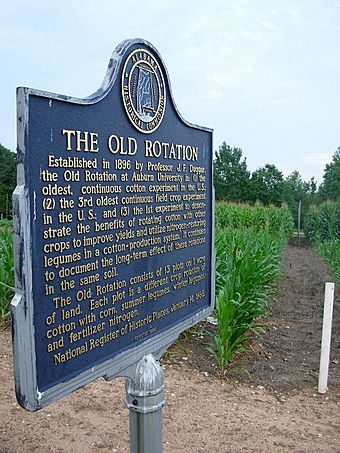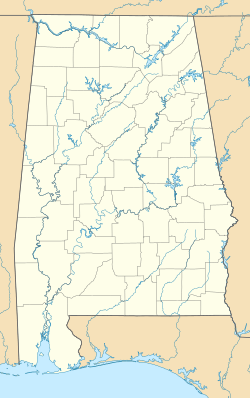Old Rotation facts for kids
Quick facts for kids |
|
|
Old Rotation
|
|

The Old Rotation at Auburn University
|
|
| Location | Auburn University, Auburn, Alabama |
|---|---|
| Built | 1896 |
| NRHP reference No. | 87002390 |
| Added to NRHP | January 14, 1988 |
The Old Rotation is a very important farming experiment. It's located on the Auburn University campus in Auburn, Alabama. This experiment started in 1896. That makes it the third-oldest ongoing field crop experiment in the United States. It's also the oldest continuous cotton experiment in the entire world!
This experiment was the first to show something amazing. It proved that if you grow cotton and then a legume (like a bean or pea plant) on the same land, the soil can stay healthy. This means you can keep growing cotton there forever! The Old Rotation is so important that it's listed on the National Register of Historic Places.
A Look Back: How It Started
In the late 1800s, farmers in the Southern United States had a big problem. They kept planting cotton on the same land every year. This made the soil lose its important nutrients. Because of this, cotton crops weren't growing as well.
In 1896, a smart professor named J. F. Duggar from the Alabama Agricultural and Mechanical College decided to find a solution. He set up the Old Rotation experiment. He used a one-acre plot of land near the campus.
Professor Duggar wanted to see if growing legumes could help. He thought if legumes were planted in the winter, when cotton wasn't growing, they could put nutrients back into the soil. This way, the soil would stay healthy for the next cotton crop. This idea of rotating cotton with legumes has continued without stopping ever since!
Over time, other planting systems were added to nearby plots. These included rotations with corn, or corn and legumes, or corn, legumes, and soybeans. It quickly became clear that adding a winter legume crop really worked. It brought enough nutrients back to the soil to keep growing cotton year after year.
The Experiment Up Close
The Old Rotation experiment has 13 different plots. These plots show six main ways of planting crops:
- Control plot: Cotton is planted here every year without any rotation or extra plant food (fertilizer). This helps scientists see what happens without any changes.
- Cotton with winter legumes: Cotton is rotated with winter legumes, but no fertilizer is added.
- Cotton with fertilizer: Cotton is planted here every year, but it gets fertilizer.
- Cotton, corn, and winter legumes: These crops are rotated together.
- Cotton, corn, winter legumes, and fertilizer: These crops are rotated, and fertilizer is also used.
- Cotton, corn, winter legumes, and soybeans: All these crops are rotated together.
After more than 110 years of continuous planting, the results are clear. The plots where cotton is rotated with other crops still produce a lot of cotton. In fact, these plots grow almost three times more cotton than the plots where only cotton is planted without rotation! This shows how important crop rotation is for healthy soil.
Where to Find It
The Old Rotation is located right next to the Donald E. Davis Arboretum. You can find it on Lem Morrison Drive in Auburn. It was officially added to the National Register of Historic Places on February 14, 1988.
Photo gallery







